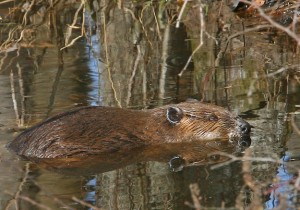Beaver: Friend or Foe?
 By Chris Nix, Wildlife Biologist, Division of Wildlife and Freshwater Fisheries
By Chris Nix, Wildlife Biologist, Division of Wildlife and Freshwater Fisheries
The North American Beaver (Castor canadensis) is the largest living rodent in North America. Although once nearly eliminated due to unregulated trapping, these animals are now abundant in the streams and wetlands throughout most of North America. While some consider beavers pests, they play a crucial role in the biodiversity of their habitat. Many species of frogs, turtles, birds and fish, some being threatened or endangered, benefit from beaver ponds. Therefore, whenever we can coexist with beavers, we are providing the habitat necessary for supporting many other species.
Beaver ponds range in size from less than 1 acre to more than 100 acres, depending on topography and the availability of food sources. Beavers will use and expand a pond area until the food supplies are exhausted. Once constructed, the benefits provided by the pond are numerous and include the following:
• Furnishing snags for cavity-nesting wildlife species.
• Supplying fallen logs, which provide cover for reptiles and amphibians.
• Providing essential edges and forest openings.
• Supplying diverse moist-soil habitats within bottomland forests.
• Benefiting productive bottomland forests.
• Improving downstream water quality.
• Providing watering holes for agricultural and wildlife needs.
• Supplying important breeding areas for amphibians and fish.
• Providing diverse wetland habitats.
• Furnishing feeding, brood-rearing and resting areas for waterfowl.
Although there are many benefits provided by beavers through their habitat modifications, extensive damage can also occur. When these modifications conflict with humans, the damage caused usually outweighs the benefits. Millions of dollars in damages occur annually due to beavers. Some of the more common negative issues caused by beavers are:
• Loss of timber due to flooding and girdling.
• Loss of crops due to flooding.
• Highway flooding.
• Damage to reservoir dams due to burrowing.
• Damage to bridges.
• Stopped up drainpipes and culverts.
• Water contamination due to the Giardia parasite.
Identifying the damage early is crucial to limit the severity of the impacts. Signs of the presence of beavers are usually easy to identify. Look for dammed-up culverts, bridges, or drain pipes resulting in flooded lands, timber, roads and crops; cut-down or girdled trees and crops; lodges and burrows in ponds, reservoir levees and dams.
If damage control is going to be utilized, it is best to start before the beavers are well established. The removal of two or three beavers is much more feasible than two or three colonies. Once the beavers are established, their range could overlap multiple landowners causing it to be nearly impossible to remove the entire problem. If you need assistance controlling or managing for beavers, contact your local state wildlife biologist or USDA-Wildlife Services personnel for assistance.
For more information, contact Chris Nix, Wildlife Biologist, 30571 Five Rivers Blvd., Spanish Fort, AL 36527; 251-626-5474; or email at chris.nix@dcnr.alabama.gov.
The Alabama Department of Conservation and Natural Resources promotes wise stewardship, management and enjoyment of Alabama’s natural resources through five divisions: Marine Police, Marine Resources, State Lands, State Parks, and Wildlife and Freshwater Fisheries. To learn more about ADCNR visit www.outdooralabama.com.
